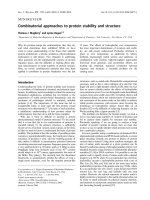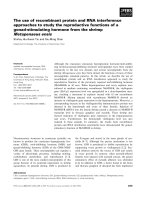Chemical proteomics approaches to study aspartic and metalloproteases
Bạn đang xem bản rút gọn của tài liệu. Xem và tải ngay bản đầy đủ của tài liệu tại đây (1.8 MB, 165 trang )
CHEMICAL PROTEOMICS APPROACHES TO STUDY
ASPARTIC AND METALLOPROTEASES
CHAN WEN SHUN, ELAINE
NATIONAL UNIVERSITY OF SINGAPORE
2004
CONTENT PAGE
Acknowledgements
i
Content Page
iii
Abbreviations
viii
List of Figures
xiii
List of Schemes
xv
List of Tables
xvi
List of Graphs
xvii
List of Amino Acids
xviii
List of Publications
xix
Abstract
xx
Chapter 1
Chapter 2
INTRODUCTION
1
1.1
Proteomics
1
1.2
Affinity-based Proteomic Profiling
4
1.3
Target-driven Selective Self-Assembly of Inhibitors
7
DEVELOPING AFFINITY-BASED PROBES FOR
14
PROTEOMIC PROFILING
2
Developing an Affinity-based Strategy for the
14
Proteomic Profiling of Aspartic and Metalloproteases
2.1
Affinity-based Proteomic Profiling of Metalloproteases
16
2.1.1
Design of Photoactivable Affinity-based Probes for
16
Metalloproteases
iii
2.1.2
Chemical Synthesis of Affinity-based Probes for
20
Metalloproteases
2.1.3
Affinity-based Enzyme Labeling Experiments
23
2.1.3.1
Optimization of Conditions for Affinity-based Profiling
24
of Metalloproteases
2.1.3.2 Mechanistic Studies of Affinity-based Labeling of
27
Thermolysin
2.1.3.3
Comparison of Photolabile Group Used in Affinity-
32
based Profiling
2.1.3.4
Affinity-based Labeling of Thermolysin in Crude Yeast
34
Extracts
2.1.4
Current Work
36
2.1.5
Conclusions
38
2.2
Affinity-based Proteomic Profiling of Aspartic
39
Proteases
2.2.1
Design of Photoactivable Affinity-based Probes for
39
Aspartic Proteases
2.2.2
Chemical Synthesis of Affinity-based Probes for
40
Aspartic Proteases
2.2.3
Affinity-based Enzyme Labeling Experiments
44
2.2.3.1
Optimization of Conditions for Affinity-based Profiling
44
of Aspartic Proteases
2.2.3.2 Mechanistic Studies on Affinity-based Labeling of
47
Pepsin
2.2.3.3
Affinity-based Labeling of Other Aspartic Proteases
49
iv
2.2.3.4
Affinity-based Profiling of Aspartic Proteases in Crude
50
Cell Extracts
2.2.4
Chapter 3
Conclusions
51
TARGET-DRIVEN SELECTIVE SELF-ASSEMBLY OF
53
INHIBITORS
3.1
Introduction
53
3.1.1
Target-driven Selective Self-assembly of Inhibitors
54
3.1.2
HIV-1 Protease and Amprenavir
55
3.2
Expression and Purification of Recombinant HIV-1
59
Protease
3.2.1
Small-scale Expression of HIV-1 Protease
60
3.2.2
Large-scale Expression and Purification of HIV-1
62
Protease
3.2.3
Validation of Catalytic Activity of Refolded HIV-1
65
Protease
3.2.3.1
Circular Dichroism (CD) Spectrum Analysis of
66
Renatured HIV-1 Protease
3.2.3.2
Affinity-based Labeling of HIV-1 Protease
66
3.2.3
Conclusions
68
3.3
Chemical Synthesis of Azide and Alkyne Cores
69
3.4
Target-driven Selective Self-assembly of HIV-1
72
Protease Inhibitors
3.4.1
Devising an Experimental Set-up
73
v
Chapter 4
3.4.2
RP-HPLC Analysis Results
77
3.5
Future Studies
80
3.6
Conclusions
81
EXPERIMENTAL SECTION
83
4.1
General Information
83
4.2
Developing Affinity-based Probes for Proteomic
84
Profiling
4.2.1
Chemical Synthesis of Affinity-based Probes for
84
Metalloproteases
4.2.2
Affinity-based Labeling Studies of Metalloproteases
94
4.3
Developing Affinity-based Probes for Aspartic
96
Proteases
4.3.1
Chemical Synthesis of Affinity-based Probes for
96
Aspartic Protease
4.3.2
Affinity-based Labeling Studies of Aspartic Proteases
102
4.4
Target-driven Selective Self-Assembly of Inhibitors
104
4.4.1
Expression and Purification of HIV-1 Protease
104
4.4.1.1
Small-scale Expression of HIV-1 Protease in E. coli
104
4.4.1.2
Large-scale Expression of HIV-1 Protease in E. coli
105
4.4.1.3
Extraction of HIV-1 Protease
106
4.4.1.4
Purification of HIV-1 Protease
106
4.4.1.5
Small-scale Dialysis
107
4.4.1.6
Refolding of HIV-1 Protease
107
4.4.1.7
Preparation of Samples for SDS-PAGE Analysis
108
vi
4.4.1.8
Circular Dichroism (CD) Spectra
108
4.4.1.9
Affinity-based Labeling of HIV-1 Protease
108
4.4.2
Chemical synthesis of Azide Cores
109
4.4.3
Chemical Synthesis of Alkyne Cores
121
4.4.4
Experimental Set-up for Self-Assembly of HIV-1
123
Protease Inhibitors
Chapter 5
CONCLUSIONS
124
5.1
124
Developing Affinity-based Probes for Proteomic
Profiling
5.2
Target-driven Selective Self-assembly of Inhibitors
125
Chapter 6
REFERENCES
127
Chapter 7
APPENDIX
138
7.1
138
Developing Affinity-based Probes for Proteomic
Profiling of Metalloproteases
7.2
Developing Affinity-based Probes for Proteomic
138
Profiling of Aspartic Proteases
7.3
Target-driven Selective Self-Assembly of Inhibitors
139
7.3.1
N3-Phe-sulfonamide 26a + Alkynes 28-31
139
7.3.2
N3-Leu-sulfonamide 26b + Alkynes 28-31
141
7.3.3
N3-Val-sulfonamide 26c + Alkynes 28-31
143
7.3.4
N3-Ala-sulfonamide 26d + Alkynes 28-31
144
vii
ABBREVIATIONS
2D-GE
2-Dimensional gel electrophoresis
4CR
4-Component reaction
A
Absorbance
AA
Amino acid
Ac
Acetyl
AChE
Acetylcholinesterase
ACE
Angiotensin-converting enzyme
AIDS
Acquired Immune Deficiency Syndrome
Amp
Ampicillin
aq.
Aqueous
Boc
t-Butoxycarbonyl
BP
Benzophenone
br
Broad
BSA
Bovine serum albumin
t-Bu
tert-Butyl
c
Concentration (grams per milliliter)
calcd
Calculated
o
Degree Celsius
C
CD
Circular dichroism
Cy3
Cyanine dye 3
δ
Chemical shift
d
Doublet
Da
Dalton
viii
DCC
N,N’-Dicyclohexylcarbodiimide
DCM
Dichloromethane
DCU
N,N’-Dicyclohexylurea
DIEA
N,N-Diisopropylethylamine
DMF
Dimethylformamide
DMSO
Dimethylsulfoxide
DNA
Deoxyribonucleic acid
dt
Doublet of triplet
DTT
Dithiothreitol
E. coli
Escherichia coli
EDC
1-Ethyl-3-(3-dimethylaminopropyl)carbodiimide hydrochloride
EDT
Ethanedithiol
EDTA
Ethylenediaminetetraacetic acid
eq
Equivalent
ESI
Electron spray ionization
Et
Ethyl
Ether
Diethyl ether
EtOAc
Ethyl acetate
EtOH
Ethanol
Fig.
Figure
Fmoc
9-Fluorenylmethoxycarbonyl
g
Gram
GSH
Glutathione-S-transferase
h
Hour
H
Hydrogen
ix
HBTU
2-(1-H-benzotriazol-1-yl)-1,1,3,3-tetramethyluronium
hexafluorophosphate
HIV-1
Human Immunodeficiency Virus – Type 1
HOBt
N-Hydroxybenzotriazole
HPLC
High Performance Liquid Chromatography
Hz
Hertz
Iva
Isovaleryl
k
Kilo
KHMDS
Potassium hexamethyldisilazane
Ki
Inhibition constant
LAH
Lithium aluminum hydride
LB
Luria-Bertani
LDA
Lithium diisopropyl amide
Leu
L-Leucine
LHS
Left-Hand Side
Lys
L-Lysine
µ
Micro
M
Molar
M
Milli
m
Multiplet
MCPBA
m-Chloroperoxybenzoic acid
MCR
Multicomponent reaction
Me
Methyl
MeOH
Methanol
mg
Milligram
x
MHz
Megahertz
min
Minute
mol
Moles
mmol
Millimoles
MMP
Matrix metalloproteinases
MS
Mass spectrum
MW
Molecular weight
MWCO
Molecular weight cut-off
n
Nano
NHS
N-Hydroxysuccinimide
NMR
Nuclear magnetic resonance
OD
Optical density
p
Page
PG
Protecting group
Ph
Phenyl
q
quartet
rt
Room temperature
rbf
Round bottom flask
Rf
Retention factor
RNA
Ribonucleic acid
rpm
Revolutions per min
s
Singlet
sat.
Saturated
SDS
Sodium dodecyl sulfate
SDS-PAGE
Sodium dodecyl sulfate-polyacrylamide gel electrophoresis
xi
sol.
Solution
Sta
Statine
t
Triplet
TBTU
2-(1-H-benzotriazol-1-yl)-1,1,3,3-tetramethyluronium
tetraborofluorate
Tf
Trifluoromethane sulfonyl
TFA
Trifluoroacetic acid
TFMPD
3-Trifluoromethyl-3-phenyldiazirine
TFMSA
Trifluoromethanesulfonic acid
THF
Tetrahydrofuran
TIS
Triisopropylsilane
TLC
Thin layer chromatography
Tris
Trishydroxymethyl amino methane
UV
Ultraviolet
X
Arbitrary amino acid
Z
Benzyloxycarbonyl
ZBG
Zinc-binding group
xii
LIST OF FIGURES
Figure
1
Page
Schematic representation of (A) activity-based probes; (B) affinity-
7
based probes.
2
Target-driven concept of small molecule screening.
10
3
Schematic representation of substrate-based inhibitors of
18
metalloproteases.
4
Nomenclature of substrate residues and their corresponding
19
binding sites.
5
Schematic representation of affinity-based profiling of
19
metalloproteases
6
Concentration dependent affinity-based labeling.
26
7
Effects of length of UV irradiation on labeling intensity.
27
8
Affinity-based labeling of thermolysin in the presence of a
28
competitive inhibitor.
9
Irreversible inactivation of thermolysin with EDTA.
29
10
(A) Specificity profile of thermolysin and carboxypeptidase A. The
31
enzymes were incubated with equal concentrations of the probes
8a-i; (B) Affinity-based labeling of denatured thermolysin.
11
Affinity-based labeling of enzymes with 5 µM of benzophenone-
34
tagged GGL-hydroxamate probe 9.
12
Comparison of labeling specificity of diazirine and benzophenone-
36
based probes 8a and 9 respecitively, of thermolysin spiked in a
crude yeast extract.
13
Mode of binding of statine to the catalytic Asp residues.
41
xiii
14
pH dependent labeling.
45
15
Concentration dependent affinity-based labeling.
46
16
The period of UV irradiation of pepsin-probe reaction mixture was
47
varied from 0 to 60 min.
17
Competitive labeling experiments: varying amounts of pepstatin
48
were incubated with pepsin and probe.
18
Inactivation of pepsin under alkaline conditions.
49
19
Enzymatic labeling of aspartic proteases.
50
20
Labeling studies of increasing amounts of pepsin spiked in 10 µL
51
of crude yeast extracts (5 mg/mL).
21
Optimization of conditions used for small-scale expression of HIV-
61
1 protease.
22
Large-scale expression of HIV-1 protease
62
23
SDS-PAGE analysis of eluted fractions following small-scale
64
dialysis.
24
SDS-PAGE analysis of purified protein.
65
25
Affinity-based labeling of HIV-1 protease.
68
26
RP-HPLC traces of reaction mixtures.
78
27
Schematic illustration of the target-driven selective self-assembly
79
of inhibitors concept
xiv
LIST OF SCHEMES
Scheme
Page
1
“Click chemistry” reaction between azide and alkyne.
11
2
Synthesis of tripeptidyl hydroxamate affinity-based probes of
21
metalloproteases.
3
Synthesis of affinity-based probes for aspartic proteases.
43
4
Synthetic strategy for the synthesis of the azide cores.
71
5
Synthetic strategy for the synthesis of the alkyne cores.
72
6
1,4- and 1,5-disubstituted 1,2,3-triazole regioisomers.
74
xv
LIST OF TABLES
Table
1
Page
Summary of yields of analogs of TFMPD-Lys(Cy3)-GGX-
23
hydroxamates 8a-i synthesized.
2
Summary of processing sites in the gag and gag-pol polyproteins.
57
3
Summary of diastereomeric ratio of epoxide 23.
71
4
Summary of overall product yields of the azide and alkyne cores.
71
5
Summary of conditions used for the assembly of enzymatic
76
inhibitors using HIV-1 protease as the target.
xvi
LIST OF GRAPHS
Graph
Page
1
Graph of UV absorbance at 280 nm against the volume eluted.
63
2
Far-UV CD spectrum of refolded HIV-1 protease.
66
xvii
LIST OF AMINO ACIDS
Single Letter
Three Letter
Full Name
A
Ala
Alanine
C
Cys
Cysteine
D
Asp
Aspartic acid
E
Glu
Glutamic acid
F
Phe
Phenylalanine
G
Gly
Glycine
H
His
Histidine
I
Ile
Isoleucine
K
Lys
Lysine
L
Leu
Leucine
M
Met
Methionine
N
Asn
Asparagine
P
Pro
Proline
Q
Gln
Glutamine
R
Arg
Arginine
S
Ser
Serine
T
Thr
Threonine
V
Val
Valine
W
Trp
Tryptophan
Y
Tyr
Tyrosine
xviii
LIST OF PUBLICATIONS
1. Uttamchandani, M.; Chan, E.W.S.; Chen, G.Y.J.; Yao, S.Q. Combinatorial
peptide microarrays for the rapid determination of kinase specificity. Bioorg.
Med. Chem. Lett. 2003, 13, 2997-3000.
2. Chan, E.W.S.; Chattopadhaya, S.; Panicker, R.C.; Huang, X.; Yao, S.Q.
Developing photoactivable affinity probes for proteomic profiling –
Hydroxamate-based probes for metalloproteases. (Manuscript submitted to J.
Am. Chem. Soc.)
3. Chan, E.W.S.; Yao, S.Q. Developing an affinity-based approach for the
proteomic profiling of aspartic proteases. (Manuscript submitted to
ChemBioChem)
xix
ABSTRACT
A complementary chemical proteomics approach to the activity-based
profiling strategy is described herein. Trifunctional probes, comprising of an affinity
binding unit, a photolabile group and a fluorescent reporter tag, were designed for the
affinity-based profiling of metalloproteases and aspartic proteases. Through a
repertoire of labeling experiments, the ability of the probes to selectively and
specifically capture the desired enzymes with minimal interference and background
was adequately demonstrated, laying the framework for the use of affinity-based
concept in large-scale proteomic profiling experiments.
An analogous strategy akin to the dynamic combinatorial chemistry concept is
also reported. A series of azide- and alkyne-bearing cores were prepared. Using
recombinant HIV-1 protease as a host, the sequestering of the precursors in the active
site of the enzyme resulted in the catalysis of the click chemistry ligation reaction due
to proximity effects. The preliminary results obtained at this stage sets the
groundwork for potential extension to complex systems involving multiple
components.
xx
CHAPTER 1 INTRODUCTION
1.1 Proteomics
Advances in genomics over the past few years have opened up a whole new
perspective for the life sciences arena, particularly with the completion of the Human
Genome Project [1]. With the complete sequencing of the estimated 30,000 genes in
the genome, a wealth of information is expected to be gleaned from the genetic
blueprint, sparking far-ranging implications and applications in the field of molecular
and cell biology. However, proteins, the eventual product of genetic expression, not
genes, are the ultimate factors responsible for most biological processes occurring in
the cellular machinery and the term “proteome” was coined to describe the complete
set of PROTeins expressed by the genOME [2]. Proteomics - the study of the
proteome – thus aims to identify, characterize and assign biological functions to all
the expressed proteins.
The challenges and hurdles in proteomics are unprecedented. Proteins, unlike
the ubiquitous double helical DNA, present a far more complex façade. Studies have
shown that there is a poor correlation between the number of genes and proteins [3].
Proteins are subjected to a variety of post DNA/RNA processes, including expression
level control, compartmentalization, as well as, post-translational and posttranscriptional modifications such as phosphorylation and glycosylation [4]. A
conservative estimate of the number of structurally and functionally diverse proteins
expressed in the human genome places the figure in the range of 100,000 to
1,000,000, far exceeding the number of estimated genes [1].
1
To accomplish the Herculean effort of proteomics studies, major research
activities in the post-genomic era focus on the development of high-throughput
methods which are capable of large-scale analysis of proteins, including their
expression levels, functions, localizations and interaction networks [5-7]. The
traditional approach towards proteomics has been focused on the use of twodimensional gel electrophoresis (2D-GE) for large-scale protein expression analysis.
More recently, 2D-GE, when combined with advanced mass spectrometric
techniques, has become the state-of-the-art method for major proteomic research,
primarily due to its ability to analyze up to a few thousand protein spots in a single
experiment [5a]. By simultaneous analysis of the relative abundance of endogenous
proteins present in a biological sample, 2D-GE allows the identification of important
protein biomarkers associated with changes in the cellular/physiological state of the
sample. Most techniques based on 2D-GE, however, suffer from a number of serious
technical problems: low detection sensitivity, limited dynamic range and low
reproducibility, etc. Furthermore, when compared with other existing protein analysis
techniques, perhaps the major shortcoming of 2D-GE techniques is that, it gives rise
to only information of proteins such as their identity and relative abundance. In most
cases, no information about the protein function and biological activity can be
delineated from a 2D-based experiment [5b].
Over the years, there has been a flourish of novel approaches towards the
proteomics issue. Different spin-offs of 2D-GE have been developed in order to
address some of these technicalities [5c-f]. For example, a number of fluorescencebased protein detection methods were developed which allow highly sensitive
detection of low-abundant proteins on a 2-D gel, and at the same time achieving broad
2
linear dynamic range [5c].
Various strategies, including ICAT, isotope-based
metabolic labeling, DIGE, have been developed, allowing protein samples from
different cellular states to be simultaneously separated and analyzed, thus ensuring
quantitative comparison of the protein expression level [5d-f]. The development of
mass spectrometric techniques has also vastly improved the sensitivity of the
instrumentation. Of late, there has been a gradual shift of balance towards direct gelfree MS analysis of protein mixtures, bypassing the traditional mode of
electrophoretic separation. [5a]
Asides from quantification of protein abundance level, the mapping of proteinprotein interaction in the proteome has been the subject of groundbreaking research.
Originally designed to pull-down a single protein interaction partner, the yeast-2hybrid (Y2H) system has evolved into a high-throughput manner capable of mapping
the protein interaction network of up to 5,000 yeast proteins [7e]. Another emerging
facet of proteomics is the burgeoning field of array-based technologies, which have
shown great promises to be the ultimate high-throughput tool for future proteomic
research. With the protein array technology for example, it has been shown that it is
possible to immobilize the entire protein complement of yeast (e.g. ~6000 yeast
ORFs) onto a 2.5 x 7.5 cm glass surface, where different biological functions of all
yeast proteins could be studies simultaneously [6d]. The protein microarray
potentially allows for the large-scale functional and interaction studies of thousands of
proteins to be assayed in a parallel fashion.
The methods described thus far are largely reliant on technological
advancement of instrumentation as well as molecular biology protocols with
3
negligible involvement of chemistry. However, the entry of the activity-based
profiling strategy into the playing field vastly leveled the imbalance in proteomics [8].
Through the use of small molecule probes that chemically react with enzymes,
proteins can now be profiled on the basis of function. The novelty of the strategy has
given birth to a new aspect of proteomics – chemical proteomics, or the small
molecule approach towards proteomics. Small molecules are typically synthetic
organic compounds of less than 1,000 Da. Over the past decade, chemical genetics
has seen the ad hoc systematic application of small molecules for the functional
studies of proteins through their activation and/or inactivation [9]. The use of small
molecules to perturb biochemical functions of biological macromolecules generates a
plethora of data, particularly in the identification of the chemical ligands with
potential for derivitizing into therapeutic agents.
Herein, we aim to expand the scope of chemical proteomics through the
development of two novel small molecule-based approaches towards the study of
protein function – affinity-based profiling and the target-driven selective selfassembly of inhibitors.
1.2 Affinity-based Proteomic Profiling
In order to bridge the gap between technologies such as protein microarray
which primarily analyze purified proteins, and 2D-GE based techniques which study
endogenous proteins by their expression, and combine the high-throughput feature of
2D-GE with the ability of functional-based protein studies, a chemical proteomics
approach was recently developed which enables the activity-based profiling of
4
enzymes on the basis of their activity, rather than their levels of abundance [8]. The
general strategy in activity-based profiling typically involves a small molecule-based,
active site-directed probe which targets a specific class of enzymes based on their
enzymatic activity.
The design template for activity-based probes essentially
comprises a reactive unit, a linker unit and a reporter unit, in which the reactive unit is
derived from a mechanism-based inhibitor of a particular enzymatic class (Fig. 1A).
By reacting with the targeting enzymes in an activity-dependent manner, the reactive
unit serves as a “warhead” for covalent modification, thus rendering the resulting
probe-enzyme
adducts
easily
distinguishable
from
other
unmodified
enzymes/proteins. The reporter unit in the probe is either a fluorescence tag for
sensitive and quantitative detection of labeled enzymes, or an affinity tag (e.g. biotin),
which facilitates further protein enrichment/purification/identification. A number of
activity-based probes have thus far been reported, some of which have been
successfully used for proteomic profilings of different enzymatic classes in complex
proteomes [8].
For instance, fluorophosphonate/fluorophosphate derivatives have
been developed to selectively profile serine hydrolases, including serine proteases
[10a, b]. For cysteine proteases, different classes of chemical probes have been
reported, including probes containing α-halo or (acyloxy)methyl ketone substituents,
epoxy- and vinyl sulfone-derivatized peptides [10c-h]. Other known activity-based
probes include sulfonate ester-containing probes that target a few different classes of
enzymes [10i], as well as probes conjugated to p-hydroxymandelic acid which
specifically label protein phosphatases [10j,k].
Herein, we describe a complimentary strategy for proteomic profiling of
enzymes without the need of mechanism-based suicide inhibitors.
Our strategy
5
utilizes chemical probes that are made up of reversible inhibitors of enzymes (Figure
1B): each probe has an affinity binding unit, a specificity unit and a photolabile
group. The affinity unit comprises a known reversible inhibitor that binds to the
active site of the target enzyme (or a specific class of target enzymes) non-covalent
and tightly. We capitalize on the wealth of information available on noncovalent
inhibitors of enzymes, thus allowing the applicability of our affinity-based strategy to
most classes of enzymes. The specificity unit, on the other hand, could be a specific
peptide sequence serving as the recognition group of the target enzyme, or a simple
linker, which confers minimum substrate specificity towards most enzymes in the
same class. Because the enzyme-probe interaction is solely based on affinity, an
additional moiety, e.g. the photolabile group in our strategy, is thus required to effect
a permanent attachment between the said molecules of interest. The incorporation of
a fluorescent tag eventually results in a trifunctional affinity-based probe for potential
large-scale protein profiling experiments (Fig. 1B). Photoaffinity labels, such as
those containing diazirine and benzophenone, have been used to covalently modify
molecules in a variety of biological experiments [11]. These photoactivable labels
operate by generating reactive intermediates such as carbenes, nitrenes and ketyl
biradicals, which result in permanent crosslinkage within the vicinity of the enzymatic
active site [11]. The selected wavelength for UV irradiation is usually greater than
300 nm, thus preventing potential photochemically induced damage to the enzyme.
Overall, our affinity-based approach thus takes advantage of the reversible inhibitor
of an enzyme which functions as the “Trojan horse” - it first ferries the photo-labeled
affinity probe to the enzyme active site. Upon UV irradiation, the photolabile group
in the probe irreversibly modifies the enzyme and forms a covalent enzyme-probe
6









